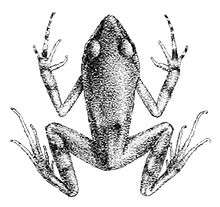Arthroleptis poecilonotus
| Arthroleptis poecilonotus | |
|---|---|
 | |
| Scientific classification | |
| Kingdom: | Animalia |
| Phylum: | Chordata |
| Class: | Amphibia |
| Order: | Anura |
| Family: | Arthroleptidae |
| Subfamily: | Arthroleptinae |
| Genus: | Arthroleptis |
| Species: | A. poecilonotus |
| Binomial name | |
| Arthroleptis poecilonotus Peters, 1863 | |
| Synonyms | |
|
Arthroleptis macrodactylus Boulenger, 1882 | |
Arthroleptis poecilonotus (common names: West African screeching frog, mottled squeaker) is a species of frog in the family Arthroleptidae.[2] This adaptable species has a wide range and is not considered threatened.
Distribution and taxonomy
Arthroleptis poecilonotus is widely distributed in the West African forest belt from Guinea-Bissau to Gabon, north-central Central African Republic, the Republic of the Congo, northern Democratic Republic of the Congo and extreme western Uganda, possibly as far as South Sudan. It is also present on Bioko.[2] The IUCN SSC Amphibian Specialist Group[1] lists the following countries: Benin, Cameroon, Republic of the Congo, Democratic Republic of the Congo, Ivory Coast, Equatorial Guinea, Gabon, Ghana, Guinea, Guinea-Bissau, Nigeria, Uganda, Sierra Leone, South Sudan, and Togo. There are no records from the Central African Republic nor from Liberia, although the species is likely to be present there.[1] The taxonomic status of the nominal species is problematic, with one species (or more) representing western parts of its range, and another one in the eastern parts.[1] Arthroleptis bivittatus and Arthroleptis zimmeri are possibly junior synonyms of this species.[1][2]
Habitat
Arthroleptis poecilonotus inhabits secondary herbaceous growth in the forest zone. It also occurs in clearings and along forest tracks, and in towns and villages.[1]
Ecology
Arthroleptis poecilonotus breeds away from water-bodies, laying its eggs on the ground where the developing larvae undergo direct development into juvenile frogs.[1]
Status
Arthroleptis poecilonotus is a common species facing no particular threats. It has a wide distribution and is presumed to have a large total population. It is present in some protected areas, and the International Union for Conservation of Nature has assessed its conservation status as "least concern".[1]
References
- 1 2 3 4 5 6 7 8 IUCN SSC Amphibian Specialist Group (2013). "Arthroleptis poecilonotus". IUCN Red List of Threatened Species. IUCN. 2013: e.T54380A18363764. Retrieved 27 March 2016.
- 1 2 3 Frost, Darrel R. (2016). "Arthroleptis poecilonotus Peters, 1863". Amphibian Species of the World: an Online Reference. Version 6.0. American Museum of Natural History. Retrieved 27 March 2016.
